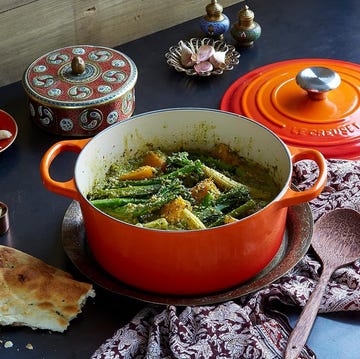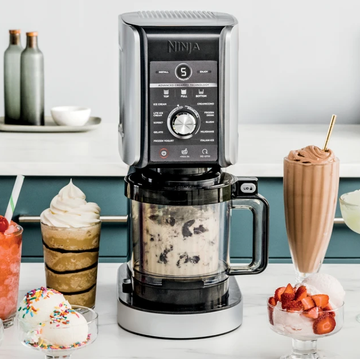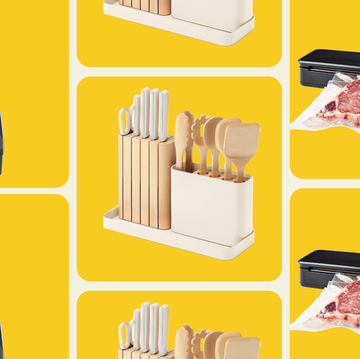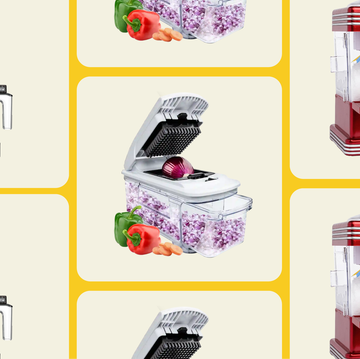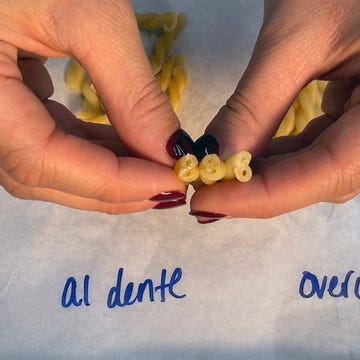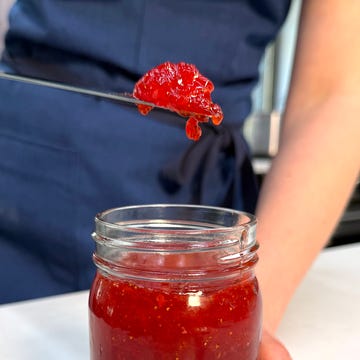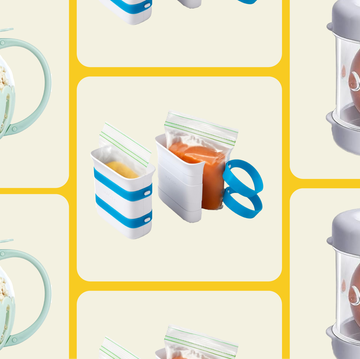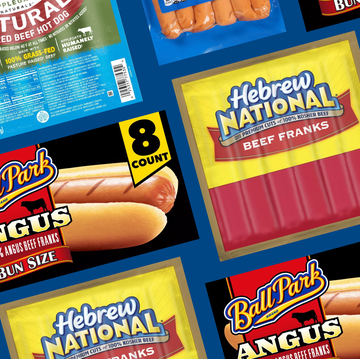1Rethink Your Walls
 Photo by Kathryn Wirsing; Design by Betsy Farrell
Photo by Kathryn Wirsing; Design by Betsy Farrell 2Nestle Wine Glasses
 Photo by Kathryn Wirsing; Design by Betsy Farrell
Photo by Kathryn Wirsing; Design by Betsy FarrellTo make more space in your cabinet, add a riser ($7, amazon.com) for plates and bowls, then alternate the direction you stand your wine glasses to fit more onto your shelf.
Advertisement - Continue Reading Below
3Use Cabinets Strategically
 Photo by Kathryn Wirsing; Design by Betsy Farrell
Photo by Kathryn Wirsing; Design by Betsy FarrellIf you don't consider your baking dishes day-to-day essentials, storing them out of reach is just fine. Here, two risers ($7, amazon.com) create ample room for nine dishes on two separate shelves.
4Don't Overpack Cabinets
 Photo by Kathryn Wirsing; Design by Betsy Farrell
Photo by Kathryn Wirsing; Design by Betsy FarrellKeeping tabs on the food you already have is all about creating categories that work for your household. Here, snacks go on the bottom shelf, while breakfast foods and sweets go on the second shelf. The third is left empty for inevitable overflow.
Advertisement - Continue Reading Below
5File Your Platters
 Photo by Kathryn Wirsing
Photo by Kathryn WirsingThis filing organizer (similar for $6, amazon.com) is ideal for heavy serving platters, cutting boards and trays because it screws into the bottom of the cabinet and won't wiggle as you pull items in and out.
6Use Your Doors
 Photo by Kathryn Wirsing; Design by Betsy Farrell
Photo by Kathryn Wirsing; Design by Betsy FarrellThe inside of cabinet doors is one of most under-utilized spaces in most kitchen. Use hooks and caddies ($5, amazon.com) to add extra storage. And your grocery bags can organize themselves when you take the time to fold them up carefully.
Advertisement - Continue Reading Below
7Use Clear containers
 Photo by Kathryn Wirsing; Design by Betsy Farrell
Photo by Kathryn Wirsing; Design by Betsy Farrell
Items that your family always keeps on hand are best stored in clear containers ($14, amazon.com) — this way you can see when you're running low and add them to your shopping list.
8Nestle Your Utensils
 Photo by Kathryn Wirsing; Design by Betsy Farrell
Photo by Kathryn Wirsing; Design by Betsy FarrellAfter adding plastic caddies ($6, amazon.com) to help organize your utensil drawer, go the extra step and nestle your spoons and forks together so you can fit in as many as possible.
Advertisement - Continue Reading Below
9Think About Weight
 Photo by Kathryn Wirsing; Design by Betsy Farrell
Photo by Kathryn Wirsing; Design by Betsy Farrell
Items like cast iron skillets and Dutch ovens should always go in the lowest cabinet possible, partly because it's safer to pull them out that way and you also won't have to worry about the shelf they're sitting on collapsing under their weight.
10Look Up
 Photo by Kathryn Wirsing; Design by Betsy Farrell
Photo by Kathryn Wirsing; Design by Betsy FarrellBy adding extra shelves ($16, amazon.com) for spices, this previously wasted wall becomes a handy storage spot for dinnertime favorites.
Advertisement - Continue Reading Below
11Go Back to Basics
 Photo by Kathryn Wirsing; Design by Betsy Farrell
Photo by Kathryn Wirsing; Design by Betsy Farrell
Many people find food storage containers intimidating to corral, but this cabinet makes it look easy by using a riser ($7, amazon.com) to separate round shapes on top and square ones on bottom.
12Get Creative
 Photo by Kathryn Wirsing; Design by Betsy Farrell
Photo by Kathryn Wirsing; Design by Betsy FarrellYour storage doesn't have to be used in the way it was originally intended. Instead of hanging towels, this rack holds pot and pan lids whose counterparts are hung on the wall nearby.
Advertisement - Continue Reading Below
13Look Above Your Range
 Tidbits
TidbitsWhen you store your pots and cooking utensils above your stovetop, everything you need is always at-hand.
See more at Tidbits »
14Choose a Hollow Island
 Mom 4 Real
Mom 4 RealFrom the front, this piece looks like your average island — but from the back it's storage central for everything you want (cookbooks, holiday accessories), but never seem to have enough space for.
See more at Mom 4 Real »
Advertisement - Continue Reading Below
15Build a Better Bench
 Simplified Bee
Simplified Bee 16Try a Tilt
 Domestically Speaking
Domestically Speaking Advertisement - Continue Reading Below
17Be Narrow-Minded
 Classy Clutter
Classy Clutter 18Display What You Can
 Oliver and Rust
Oliver and Rust Advertisement - Continue Reading Below
19Utilize Baskets
 A Beautiful Mess
A Beautiful Mess 20Give Essentials a Lift
 The Kitchen
The Kitchen Advertisement - Continue Reading Below
Advertisement - Continue Reading Below
Advertisement - Continue Reading Below


